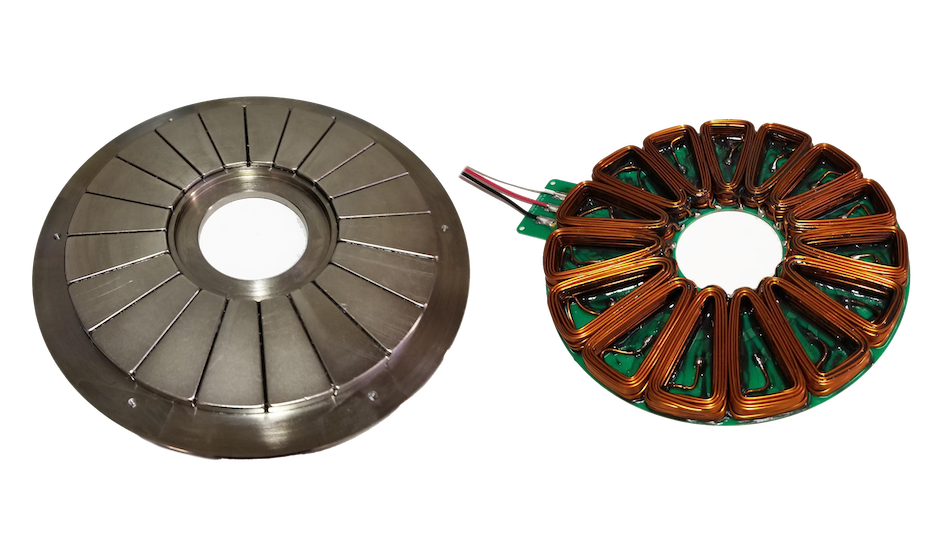
STSA Axial Flux Motors are excellent for low profile applications: moving cameras, gimbals and scanning or imaging systems. Their large apertures enable unique spacial opportunities for the required process and application. These motors are also slotless, and therefore have zero cogging torque, enabling ultra precise movement at low speeds where the benefits of inertia do not exist. Sierramotion offers an integrated encoder solution, further simplifying integration into the motion assembly. STSA motors are easily scalable to large diameters with a seamless transition to a modular construction. Contact Sierramotion to discuss how STSA motors can unlock your motion solution needs.
Low axial profile
Axial lengths as small as 5mm are possible. These motors are great for integration with a gimbal system or pan and tilt application. They can also move large gantry systems for MRI and CT Scanning machines.
Completely configurable to the application
The axial flux motor is simply coils mounted on a PC board, flex circuit or in a coil assembly, and a magnet that is axially magnetized. Motors can have optional pole counts from 4 to more than 100 poles.
Optional winding and impedance matching
Whether it is low voltage or high voltage, low current or high current (battery) operation, the axial flux motor is probably the most configurable to the application needs and control system.
Torque Linearity
Motors with iron tend to saturate. It is common for motors to already be in saturation at their thermally rated limits. If torque linearity is important care needs to be taken to mitigate saturation. Control systems do not non-linear.
Sinusoidal torque versus angle curves
Synchronous motor run best with sinusoidal current control methods. The torque production with angle needs to meet this criteria by design. Non sinusoidal torque profiles can cause torque ripple and speed ripple.
Moving magnets
Axial flux motors are easily configured for moving magnet applications. A complete motor will rotate continuously. An Arc shaped segment can be utilized for limited motion.
STSA Axial Flux Motor specifications
| STSA-100-A-11 | STSA-102-A-10 | STSA-170-A-30 | STSA-222-A-34 | STSA-283-A-35 | STSA-1795-A-50 | |
| Stator OD, mm | 99.1 | 102.0 | 170.0 | 222.0 | 283.0 | 1795.0 |
| Length, mm | 11.1 | 9.8 | 30.4 | 34.0 | 35.4 | 50.0 |
| Rotor ID, mm | 25.0 | 77.0 | 50.0 | 128.7 | 155.7 | 1541.0 |
| Rated Torque, NM | 0.46 | 0.38 | 1.19 | 1.92 | 4.31 | 49.90 |
| Rated I Amp DC | 3.21 | 5.64 | 7.64 | 1.92 | 0.90 | 4.58 |
| Peak Torque** NM | 1.39 | 1.13 | 3.57 | 5.76 | 12.93 | 149.69 |
| Volts* | 60 | 24 | 60 | 60 | 60 | 320 |
| Rth | 2.75 | 2.75 | 4.5 | 1.5 | 1.5 | 1 |
| Rated Speed, RPM*** | 2980 | 2571 | 2761 | 430 | 90 | 211 |
| Km NM/watt1/2 | 0.075 | 0.061 | 0.246 | 0.229 | 0.515 | 4.869 |
| Kt NM/ADC I-I | 0.144 | 0.067 | 0.156 | 1.000 | 4.776 | 10.888 |
| Ke v/krpm I-I | 15.1 | 7.0 | 16.3 | 104.7 | 500 | 1140 |
| R, Ohm I-I | 3.70 | 1.20 | 0.40 | 19.00 | 86.00 | 5.0 |
| L, mH I-I | 0.5 | 0.5 | 0.4 | 6.0 | 60.0 | 7.5 |
| Poles | 28 | 24 | 20 | 40 | 40 | 80 |
| Need a modified or custom solution? Send us an inquiry and we would be happy to discuss. | ||||||
| *Motors can run on buss voltages 12VDC to 325VDC. Speed is proportional to voltage | ||||||
| **Peak torque is intermittent assuming a <10% duty cycle for 1-3 seconds. Also assumes there is enough voltage to meet this point. | ||||||
| ***Rated speed calculated based on available voltage and motor parameters. Rated speed is point where full rated torque is still available. | ||||||
| Rated torque is based on ambient temperature and nominal thermal resistance values for motor mounted into a typical housing | ||||||
| Model number defines a motor kit, Stator + Rotor | ||||||
Frequently asked questions
Torque is produced through a magnetic field interaction that is axial rather than radial. These motors lend themselves to be very low profile axially. The axial flux motor is similar to a linear motor that is bent around in a circle. It is naturally a moving magnet motor.
As with many motor types, if an iron core is present then then cogging torque is typical. Most axial flux motors to not have iron cores and therefore they do not exhibit cogging torque.
It all depends on motor construction. Axial flux motors that are also slotless would produce less torque than radial flux motors. If iron is used between the coils, axial flux motors can have very high torque rivalling radial flux motors if multiple stacks are use to make the equivalent motor length.
Axial flux motors have multiple stator coils adjacent to permanent magnets and have iron only between the coils (if there is iron at all). Transverse flux motors use iron in three dimensions and a simple toroidal coil centrally located to create the electromagnetic field.
Most small motors including axial flux motors operate on low voltage, 24-80 volts DC. Larger versions can operate up to 600 volts with the proper insulation system and a control system that can handle the motors’s low inductance.

